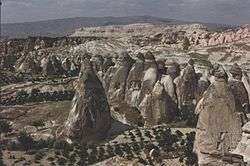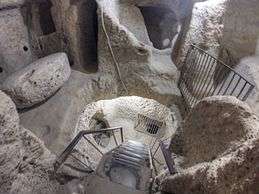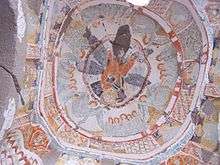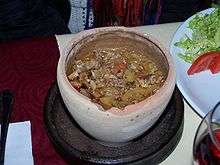Cappadocia
Cappadocia (Turkish: Kapadokya) is an area in Central Anatolia in Turkey best known for its unique moon-like landscape, underground cities, cave churches and houses carved in the rocks.
Understand
The ancient region of Cappadocia is located in central Anatolia between the cities of Nevsehir, Nigde and Kayseri. Millions of years ago violent eruptions of the volcanoes Mount Erciyes and Mount Hasan covered the surrounding plateau with tuff. Wind and weather have eroded the soft volcanic rock into hundreds of strangely shaped pillars, cones and "fairy chimneys", in colours ranging from pink to green and yellow. Since antiquity, people have hollowed out these soft rocks, and they have made countless cave churches, chapels and monasteries.
The churches are from the early Christianity. The art style of the churches can be classified into two categories: the 8th and 9th century are the iconoclastic years, the 10th to the 13th centuries whose decorations represent the lives of Christ and various saints. The architecture of the churches are uncomplicated.
History
The prehistoric settlements of the area are Koskhoyuk (Kosk Mound) in Nigde, Aksaray Asikli Mound, Nevsehir Civelek cave and, in the southeast, Kultepe, Kanis and Alisar in the environs of Kayseri. This area with unusual topographic characteristics was regarded as sacred and called, in the Scythian/Khatti language, as Khepatukha, meaning "the country of the people of the chief god Hepat", although there are more poetic claims on the origin of the region's name, such as the Old Persian Katpatuka, which is said to mean "the land of beautiful horses". The tablets called Cappadocian Tablets and the Hittite works of art in Alisar are of the important remains dating from the 2000s BC. After the 1200s BC, the Tabal principality, of the Khatti Branches of Scythians, became strong and founded the Kingdom of Tabal. Following the Late Hittite and Persian aras, the Cappadocian Kingdom was established in 332 BC. During the Roman era the area served as a shelter for the early escaping Christians. There are also several underground cities used by early Christians as hideouts in Cappadocia.
When the Turks started to arrive in the region after immigrating from their homeland in Central Asia around the 11th century, they found the area largely uninhabited. Seeing the strange, upheld rock formations drilled inside out as they were, they concluded that these should have been the chimneys of the homes of the otherkin, thus providing the popular name for the "fairy chimneys" (a direct translation of Turkish peri bacası).
Cities

- 🌍 Avanos — pottery town located on the banks of the longest river in Turkey - Kizilirmak river
- 🌍 Cavusin
- 🌍 Göreme — fairy chimneys in the rock city. One of the main tourist spots in Cappadocia.
- 🌍 Güzelyurt — historic town close to Ihlara Valley
- 🌍 Nevsehir — capital of the region
- 🌍 Ortahisar — features rock castle
- 🌍 Uçhisar — superb views of the Cappadocia valley that can be seen from its rock castle
- 🌍 Ürgüp — cave dwellings, as well as the rock cones in and around this city

Other destinations
- Ihlara Valley (Ihlara Vadisi) — lots of churches carved into rocks, this valley is about an hour west of the core of Cappadocia, i.e. Ürgüp/Göreme area.
Get in
|
Discouraged by its remoteness?
|
By plane
The fastest and most comfortable way of reaching Cappadocia is using the airway. There are two main airports that you can use to reach Cappadocia. One of them is Kayseri Erkilet Airport (ASR IATA) located in Kayseri and nearly one hour driving to the center of Cappadocia region. Turkish Airlines operates several direct (nonstop) flights from Istanbul Atatürk Airport (IST IATA) to Kayseri Erkilet Airport. There are also daily flights from Izmir into Kayseri via Istanbul. It's easy to arrange a transfer or shuttle bus from Kayseri Airport to Cappadocia.
The second one is Nevşehir Kapadokya Airport (NAV IATA), which is located in Gülşehir town of Nevşehir Province. Turkish Airlines operates direct (nonstop) flight from Istanbul Atatürk to Nevsehir Kapadokya twice a day.
By train
Kayseri is on a busy railway route. It is possible to find suitable trains to Kayseri from almost all the train stations of Turkey. From Kayseri, you can take bus to go to Göreme.
Get around
The region has a very low population density, limited public transportation, and the sites are very far apart, so you may want to consider either renting a car or buying a tour package.
However, you may come across exorbitantly priced car rentals, as much as 100 TL per day. Bargaining is needed in such instances.
See
- Old Greek houses in Sinasos
- Göreme Open Air Museum and Dark Church - is a complex of churches and chapels, dating back to 10th century. There are great frescoes in many, Yilanli Church, Tokali Church are among the most important.

- Mustafapaşa and İbrahimpaşa towns
- Ihlara Canyon- beautiful canyon with cave churches dug out of the walls of the valley. You are urged to walk along the valley and explore the churches and its numerous frescoes.
- Zelve Open Air Museum - a ghost town with lots of caves. It's about 10 km from Goreme or 5 km from Avanos.
- Zelve is also one the most impressing valleys in the region offering a more disorganised and rough hike.
- Gümüşler Monastery (10 km from Niğde in the village of Gümüşler). Spectacular monastery carved in rock, hidden from the outside world. Dated at 10-11th century and only recovered in the 1960s. The ticket seller speaks some English and can give you a tour. The monastery has some well preserved frescoes, including the only smiling (Mona Lisa-style) Madonna in the world. 3 TL.
Underground cities

Also there are ancient underground cities which have up to 8 stories of underground tunnels and caves, about 85 m deep. There were rooms for grain storage, sleeping chambers, kitchens and ventilation shafts. Long time ago they've been used as hiding places during times of raids. But now they work as museums and are open to the public.
The underground cities of Kaymakli and Derinkuyu are the two most important.
- 🌍 Derinkuyu, Derinkuyu town (29 km from Nevşehir, on the road to Niğde), ☎ +90 384 271 21 67. April–October 08:00 - 19:00, November–March 08:00 - 17:00. Largest excavated underground city in Turkey built in the 8th–7th centuries BC. About 10% of it is accessible to visitors now. 25 TL.
- 🌍 Kaymaklı, Kaymaklı village (19 km from Nevşehir, on the road to Niğde). April–October 08:00 - 19:00, November–March 08:00 - 17:00. Kaymaklı's structure and layout is different from Derinkuyu: the tunnels are lower, narrower, and more steeply inclined. It has 4 floors opened for visitors. 20 TL.
- 🌍 Özkonak (N 14 km of Avanos). April–October 08:00 - 19:00, November–March 08:00 - 17:00. Features only one underground floor, although it covers a large area. 10 TL.
- Gaziemir (between Kaymakli (35 km from it) and Ihlara valley (25 km)), ☎ +90 554 5411401, e-mail: cappadociaundergroundcity@hotmail.com. 08:00 - 20:00. It has two underground churches, camel staying place (which is the only one underground caravansary in the Cappadocia) and a large agora.
- Mazıköy
Do
- Hiking - Following the paths along the valleys is an amazing (and free) option. Check with your hotel owner or the tourist office for a map of the area with suggested walks and trails. There are several nice loops on packed dirt, sand and rock, that maintain a constant elevation and pass through the scenic valleys.
- Güvercinlik (Pigeon) Valley - You can hike the Pigeon Valley between Göreme and Uçhisar. The 4-km trail starts from the road near the Ataman Hotel on the south side of Göreme or on the paved road on the north side of the hill where Uçhisar Castle sits in Uçhisar. Both trailheads are signed. Stick to the more traveled trails and you will have no trouble finding your way on this moderately hilly hike. The path through the valley offers spectacular views of the natural cliffs and the man-made caves and passes through a few tunnels carved into the rock.
- Rose Valley (From Çavuşin, Ortahisar and Kızılçukur). Beautiful green valley.


- Organized tours - Every travel agency offers the "red", "green" and "blue" tour, and the itinerary is essentially the same no matter who you purchase the tour from. Tours will include transportation, but verify whether lunch and entrance fees are also included. Names and itineraries change occasionally, but expect that whatever name and itinerary is used at one agency will be the same at the others. However private tours are not the same so is the experience.
- The Red Tour is the most basic, visiting sites in the immediate vicinity of Göreme including the open-air museum, the castle at Uçhisar, and the pottery shops at Avanos.
- The Green Tour is a bit more adventurous, visiting the Pigeon Valley and then going farther afield to visit Derinkuyu Underground City, Nar Lake, Ihlara Valley and Selime.
- The Blue Tour is the most off-the-beaten path of the three tours, taking visitors to the former Greek town of Mustafapasa, the monastery at Soganli.
- Hot Air Balloon Tours are one of the most popular activities in Göreme. Typically lifting off at sunrise, these rides last about an hour in the air and literally go wherever the wind may blow in the Cappadocia Valley. The balloon baskets hold around 20 people with the pilot riding air currents much like a boat, floating down the valleys, often below the ridge line and quite close to the chimney rocks. It's a fantastic ride and if you've ever had the urge to splurge on a balloon ride, this would be the place to do it. There are 25 balloon companies in the region.
- Cross Golf. Cappadocia is a national park and its natural environment must be protected for everyone to enjoy today and in the future. Cross Golf uses the natural features of the landscape to challenge even the most experienced golfer. The fairy chimneys, fascinating rock formations and flora and fauna in the unique environment of Cappadocia remain unaffected by Cross Golf.
Eat
Dishes:
- Dry apricots and grapes
- Mantı (kind of ravioli with minced meat served with yoghurt and garlic sauce)
- Testi Kebap (jug kebap)- Meat and vegetables cooked in a clay pot (or jug) sealed with bread dough. The pot is broken when serving.

- Pastirmali kuru fasulye (white beans with spiced meat)
- Local wines - Cappadocia is one of the biggest wine-producing regions in Turkey, and many wineries thoroughout the region's towns offer winetasting options.
- sweets
Places:
- Grape Church (near Uzumlu Church in Kizil Vadi=Red Valley), e-mail: kizilcukuribrahim@hotmail.com. Excellent local cuisine and inspiring amosphere. Run by Ibrahim Sakinan. Has a few rooms to sleep.
Drink
A trip to Cappadocia is not complete without visiting the Turasan Wine Factory. The grapes which are collected from local farmers are used for producing the world wide famous Cappadocia wines.
Sleep
Visitors are recommended to stay in one of the cave hotels which are the speciality of the region. There are also many accommodation options in Urgup, Goreme, Uchisar, Ortahisar and Avanos towns for every budget.
You can find also bewitching historical Greek mansions and cave hotels in Güzelyurt.
From five-star hotels to little hostels, there is a variety of accommodation facilities in Cappadocia. However, the towns of Ibrahim Pasa (Babayan) and Ayvalı are probably the most authentic ones. The restored Greek houses offer cave and arched rooms offer pleasant accommodation.
Buy
Cappadocia is an important area for shopping, with wonderful carpets and kilims, hand made local pottery by artizans and very local wines.